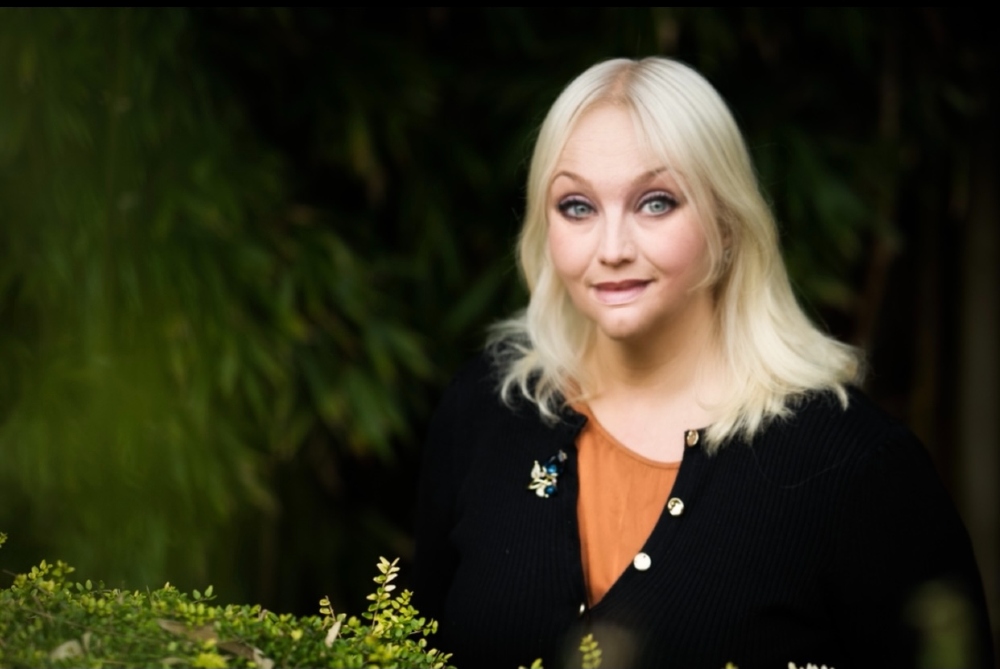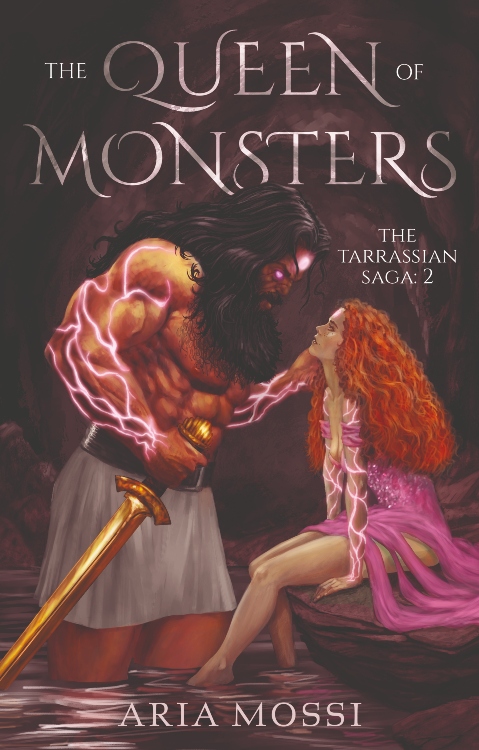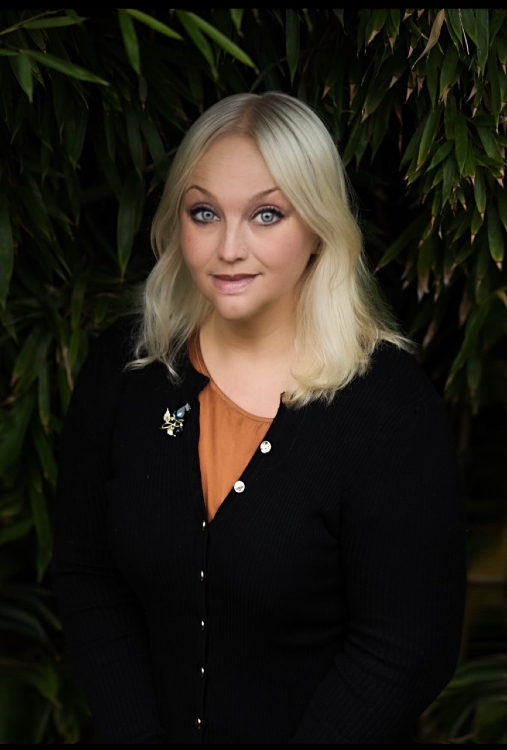Earlier this year, author Aria Mossi made her literary debut, inviting readers into an epic alien universe which sees a small band of abducted humans battling for survival in an unforgiving environment. Along the way, they are destined to find their soul mates and true love, if they don’t get devoured first by arch-fiend and mythical beast, The Sphinx.
To mark the publication of The Queen of Monsters—the second novel in her acclaimed sci-fi fantasy romance series, The Tarrassian Saga, we spoke with Aria to find out more about her work, her life, and what’s in store for readers moving forward.

When did you first realise you wanted to become an author?
The love for reading and writing was planted from a very young age. My parents’ living space was just one huge library. My most vivid childhood memories are all about stories. The ones my grandmothers used to tell me, the books I was devouring from a very young age, and the lives of the people around me. All those inspiring stories gave me strength and hope when I needed it most. I became an author hoping my own stories would do the same for others.
What has been the greatest writing challenge you have faced, and how did you overcome it?
English is no more, no less than my fifth language! It makes writing twice as hard, and I always question myself. I am not worried about things such as spelling or grammar. Those happen to all writers, no matter where they are from originally. Things such as online grammar assistants and proofread editors can easily help with that.
I worry about slang, authenticity and paragraph flow. On the bright side, since the process is more challenging for me, I was brave enough to write my books in different English dialects. The Ice Queen is in British English, The Queen of Monsters and The Warrior Queen (my next novel) are in American English. My next character is Irish, and I am having so much fun with that.
How would you sum up the key premise of your novels to someone who has never read them before?
The novels in The Tarrassian Saga follow the epic journey of five humans, four women and one man, who have been abducted from Earth by alien slavers. In a world obsessed with ancient legends, myths and power, the most unassuming traits of humanity—the ones that we simply take for granted—will come together to solve a puzzle that holds nothing less than the answer to the survival of all sentient species in the universe.
Your novels are connected by a deep belief in the uniqueness and uplifting nature of the human spirit. Tell us more about this view, and how it is expressed in your novels?
I was about nine when I read my first Holocaust story. I somehow became obsessed with the topic. My friends used to question my love for sad books about victims. In fact, they are exhilarating books about survivors. Then I discovered Dostoevsky, and I was forever in love with the Human Spirit—I write that phrase in capitals for a reason.
The five human protagonists in my series have no special powers. They cannot, for instance self-heal; they have short life spans (compared to the aliens); their bodies are vulnerable, and their intelligence is, again in comparison to aliens, lacking. They therefore find themselves stranded in a world where they are either seen as a primitive species or, worse, prey. However, faced with inevitable destruction, these five humans will do what humans do best—survive.

Some of your younger fans cosplay your characters. What do you think of this?
This was very unexpected and a pleasant surprise. It is humbling when people leave a nice review, but cosplay? One of my dearest American fans goes all the way with hair extensions, tattoos and Tarrassian dresses. As I said, it’s humbling.
Your novels feature the concept of pre-destined romantic partners, indicated through a type of permanent tattoo that develops upon first meeting. Can you tell us more about this interesting idea?
The concepts of fated mates and alien mating marks have been around for a very long time. The only reliable information on the topic is that people argue about the origin of the idea. After reading all the good and the bad books with this theme, I made sure my concept was highly personalised.
My fated mates develop something the Tarrassians refer to as “The Sign”. It is a series of vine-like glowing tattoos which develop on the upper hands, go up the arms, shoulders and culminate on the forehead with The Sign. Each couple has a symbol representing a different Tarrassian clan and unique colours that the human partner gives.
All the symbols represent something important to me. The Tarrassian water lily is an exact replica of my grandmother’s brooch; the sacred Oria bird is the robin that watches me as I write my books in the garden. The symbols that will follow in the later books are still a secret, but they also mean something to me.
Why did you choose to write within the sci-fi fantasy romance genre, as opposed to straight sci-fi or fantasy?
Choosing this genre was actually born of necessity, and I have followed in the footsteps of a few America female authors who, like me, are passionate about sci-fi and fantasy but found that the publishing world is seemingly closed to female writers in these genres. While I hesitate to say they are strictly male preserves, it does seem to be the case. Lo and behold, though, once another genre—romance—was added to the mix, suddenly their previously rejected manuscripts were acceptable to publishers.
Some may think that taking this route is a comprise but I would say it’s more about being smart and adapting to the publishing environment. I see myself as a sci-fi and fantasy writer but adding in romance, for commercial reasons, wasn’t a struggle in the slightest. Indeed, some of the greatest books of all time feature a love story irrespective of genre, so I’m in very good company!
One day, hopefully, the situation will change for female authors but, for now, I’m enjoying my chosen genre and I can’t wait to share further stories of star-crossed lovers in future instalments of The Tarrassian Saga.
You are a full-time carer to a young son with severe autism. How has this affected you, and how has writing helped you cope with this situation?
Any parent of a child with special needs understands the meaning of ‘before and after’. Everything changes. All the things we take for granted, like birthday parties, going to the park, holiday or uninterrupted sleep, become hurdles for most and simply don’t happen at all for others. You learn to live with compromising, with unrequired pity or judgemental stares. I still haven’t decided which is worse. You also get to meet perfect strangers who go out of their ways to support you and empower you, and they are the majority.
One day I realised my son’s condition became my life, and I was losing myself more with each passing day. I couldn’t go back to my teaching career on a regular basis, so I chose the dream. That is the good thing about dreams: they are always there, waiting patiently for you to grab them. Back to reality, I was very naïve about this. I planned to be a writer at night and mum during the day. It turns out those are both full-time jobs, and they love to overlap and fight each other until I beg for my very own alien abduction! So, to answer the question, I am not coping; I am getting on with it.

Your books are definitely for adults only. Why do you think it important to describe the more gory, or steamy, events in your stories?
As a rule, I like my books and movies a bit dark. Natalia, the heroine of The Queen of Monsters, finds her angels while running from monsters. I love a happy ending, but it is not for me if the whole thing is one big happy affair.
As for the steamy scenes, I never meant to get that carried away. It happens…
I don’t think I can make Santa’s good list any time soon!
How much, and what type, of research, has gone into your novels, and the series as a whole?
Two years of genre and market research, my training as a creative writing and English teacher, years of affiliation with the geekiest Star Trek fan clubs and a lifetime of reading have gone into my books.
If you could pick one character from your novels to have dinner with, who would it be and why?
No matter how many books or characters to come, I would always choose Natalia, the heroine of The Queen of Monsters.
She is a whinny, giggly chatterbox; she trips over her own feet, her hair always ends up in her mouth, and she screams “monster” at any shadow. Humans and aliens alike question her sanity, but by the time she’s done with them, they only question themselves. By age six, she took down a human trafficking organisation; she tamed a Sphinx by age 19 and married an alien God. Wouldn’t everyone want to have dinner with her?
However, if you ask my fans, I am pretty sure they would all choose the Sphinx. This is disturbing, considering he doesn’t mind humans on the menu!
Your novels avoid the usual tropes of the fantasy genre, such as dragons and vampires. Was this a conscious decision, and why do you think the stories benefit from this?
Yes, it was a conscious decision and not just in the name of bringing something different. A quarter of my diverse genetic heritage is Romanian. This may come as a shock to most but Romanian people roll their eyes each time someone mentions vampires or Dracula author Bram Stoker. As a student, I spent some of my summer holidays working as a tour guide at Bran Castle in Transylvania. Now, imagine a history and culture enthusiast dying to talk to tourists, and all they want to know is if Dracula is available to sign t-shirts! So, no vampires for me.
As for dragons, last time I checked, they require swords, saints and special powers to be defeated.
Sphinxes, however, can only be defeated with knowledge. You answer their riddle, you get to live. That is more my idea of a fantastic beast, and is why I choose a sphinx as the main baddie of the series. Besides, I am a cat person.

You have a photographic memory. Tell us more about this unusual ability and how it has helped you as an author?
It is a curse and a blessing. I didn’t know what it was for a long time. I was different, and I couldn’t explain or understand why. It is also exhausting. My brain never stops processing information and, in time, this led to awful migraines. They say ignorance is blessed. When you have a photographic memory, you cannot ignore the details you would rather not see or the memories you would rather forget.
The blessing is more related to the professional and practical side of things. I was always the best student, with minimal effort. My daughter is the same. I can never get lost and I hardly ever use the satnav.
As I write my books, the story takes place in my head like a movie. It helps hugely with descriptive writing. Sadly, I never take notes or keep any files and records. Everything related to my books is inside my head. My assistant has the patience of a saint.
Which authors do you admire most, and why?
My favourites are Fyodor Dostoevsky because his universe is beautifully dark and twisted, and Paulo Coelho because his world is full of light and mystery.
What’s next for you as an author?
The next novel in the series, The Warrior Queen, has already made its way to the publisher. I cannot disclose much, but once again, I wanted to challenge clichés and remind people that warriors come in many forms.
As a writer, you must know your readers. I didn’t start The Tarrassian Saga with the young adult or the LGTBQ+ audiences in mind. However, they seem to be my most fervent fans, so I wrote The Warrior Queen for them.
I am currently writing the fourth novel in The Tarrassian Saga, and the protagonist is a human male because they are hardly ever represented in this genre.
There will be a spin-off book or series—I haven’t decided which yet—about The Sphinx. This is a change of plans, but I always put my readers first. They said “more Sphinx!”, and I will give them more.
I am also working on an epic space fantasy aimed at the young adult audience. Is that an actual genre? I don’t know and it’s irrelevant. My favourite author, Paulo Coelho, said, “People are capable at any time in their lives of doing what they dream of.”
The Queen of Monsters: The Tarrassian Saga, and also The Ice Queen: The Tarrassian Saga, by Aria Mossi (Troubador Publishing) are out now on Amazon, priced £9.99 in paperback and £3.39 as an eBook. For more information, visit www.ariamossi.com.

